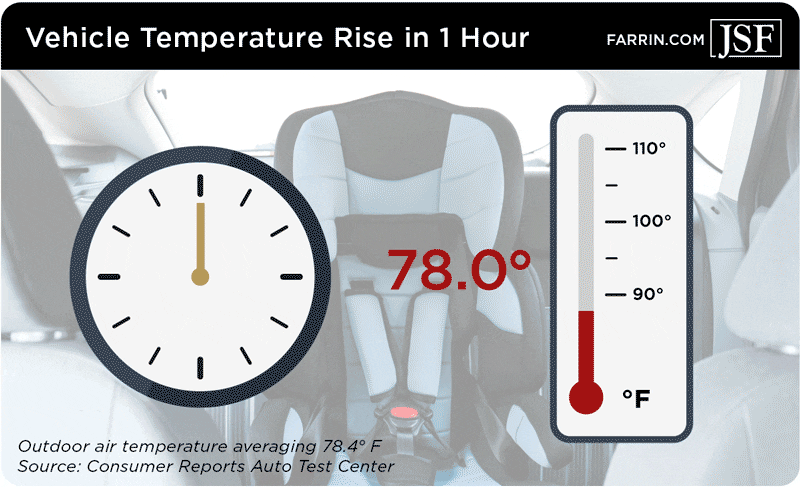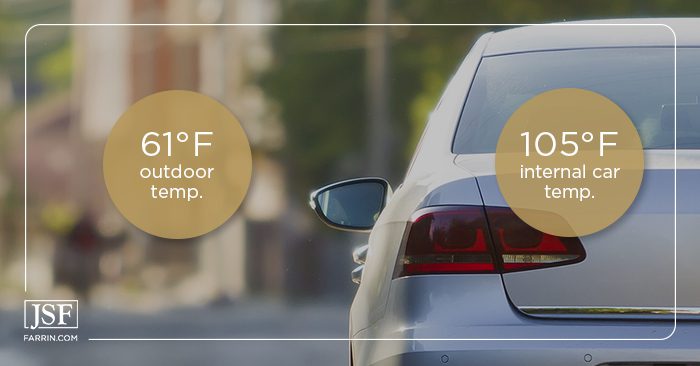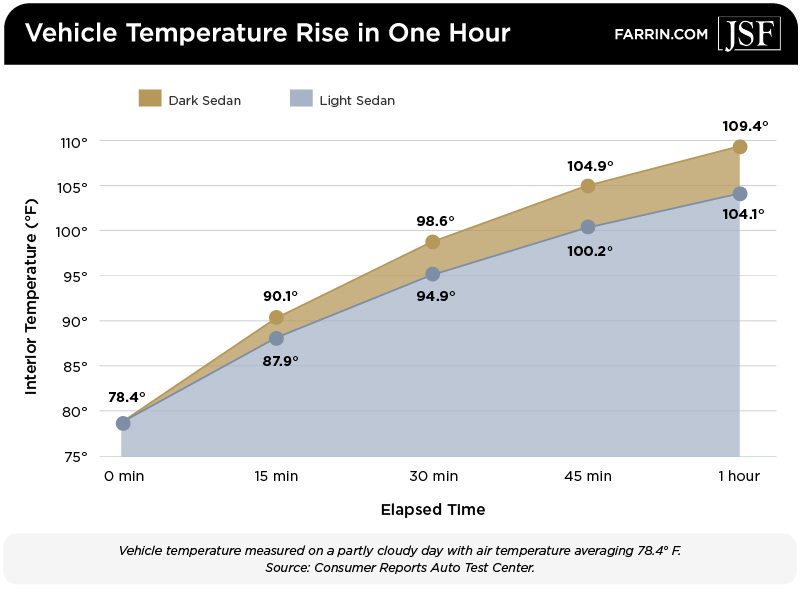We’ve all had to get into a hot car in the summer. Ever just open the door and let it “air out” because you know it’s hot in there? Even then, when you sit in the driver’s seat, the air is still stifling to breathe, and the steering wheel is so hot you can hardly touch it safely.
Children are injured in this kind of environment every single summer. It’s sometimes called “Forgotten Baby Syndrome,” but it affects more than babies, and it’s not always because they’re forgotten.
People Leave Kids in Hot Cars More Often Than You Think
Nationwide, approximately 39 children die from Pediatric Vehicular Heatstroke (PVH) each year. That’s about one death every nine days. That doesn’t include the number of children who suffer non-fatal heatstroke.
Over the last two decades, nearly 900 children have died of heatstroke from being left in the car (1998-2020). The deaths fell into a number of different categories:
- 52.9% – Child forgotten by a caregiver
- 25.6% – Child gained access to the vehicle on their own
- 19.7% – Child knowingly left by a caregiver
- 1.7% – Reason unknown
More than half of the children who’ve died of heatstroke since 1998 were simply forgotten by their parent or caregiver – so-called Forgotten Baby Syndrome. It’s happened to people from every walk of life. As of August, North Carolina is one of only two states with multiple child deaths from PVH in 2021.
When a child is left in a car as the interior heats up, they’re at risk for PVH. The condition happens quickly. Understanding why it’s so dangerous may help you or someone you love. Here’s how it works.
PVH: Heatstroke and Why Kids Overheat Far More Quickly Than Adults
As the body’s temperature rises, it begins to work to cool itself. The heart rate increases to pump blood through the body as a cooling mechanism, and the body sweats to cool itself by evaporation. However, if the environment is too hot, these biological measures cannot keep up.
Adults have more body mass than kids. That means a full-grown adult body takes longer than a child’s to reach a dangerous temperature. When a human body’s temperature reaches around 104 degrees, its ability to cool itself fails.
When someone’s body temperature reaches 104 degrees, the brain and vital organs swell and may suffer permanent damage. Without immediate aid, this condition could be fatal. Body temperatures above 104 degrees increase the likelihood of death.
Heatstroke happens over time, and most people can choose to take cooling measures before the condition becomes severe. But what if you’re a baby or a young child strapped to a car seat? What if you can’t reach the door mechanism or don’t know how to manipulate it? A common heatstroke symptom is confusion – what if a child who would otherwise know how to get in and out simply can’t remember because of the symptoms of PVH?
Warning Signs of Heatstroke
If you notice any of these symptoms, summon medical attention:
- Dizziness
- Disorientation
- Agitation
- Confusion
- Sluggishness
- Seizure
- Hot, dry skin that is flushed but not sweaty
- Loss of consciousness
- Rapid heartbeat
- Hallucinations
The Frightening Facts and Deadly Myths Around Leaving Children in Cars
When kids are walking around outside and playing, and they get hot, it happens slowly. The temperature in the yard isn’t going to increase very quickly. In a car, it’s a different story. Consumer Reports performed tests to disprove some common excuses people have for leaving their children in the car. Here are a few such excuses – and why they don’t hold water.
Even on Mild Days, People Don’t Realize How Hot the Inside of a Car Can Get
The temperature inside a vehicle can skyrocket even in mild temperatures. In April of 2020, a child gained access to the family car unnoticed. He died of PVH, and the outside temperature was only 78 degrees. According to Consumer Reports’ tests, the interior of a closed vehicle can reach 105 degrees in just an hour, even with an exterior temperature of just 61 degrees.
So while you may think you’re okay to leave your child in the car for a few minutes while you run into a store or the house, it isn’t safe.
Parking Your Car in the Shade Doesn’t Help
According to researchers at Arizona State University and the University of California at San Diego School of Medicine, finding a shady spot still poses serious danger to your child. They compared cabin air temperature and surface temperatures in identical vehicles placed in the shade and the sun. As a result of their experiment, they estimated that even in a shaded car, a 2-year-old child’s core temperature could reach 104° F in a little less than 2 hours.
Light Colored Cars Can Be Just as Deadly as Dark Colored Cars
Consumer Reports performed another test, this time with two cars of different colors. On a day with an average temperature of 78 degrees during their one-hour test period, the results could be fatal regardless of color.
The lighter-colored car’s interior temperature reached more than 104 degrees. The darker sedan’s interior temperature reached above 109 degrees. This happened in one hour, according to precision measuring instruments.
No, the lighter car did not get as hot, but to go from 78 degrees to 104 degrees – a difference of 26 degrees and climbing – in just an hour is more than enough to cause PVH.
“Just a Few Minutes” Is Just a Few Too Many
The temperature in a car can rise even higher than Consumer Reports found, and much faster. According to a study out of Stanford, interior temperatures in a car can rise very quickly. The study showed that a car’s interior temperature could increase an average of 40 degrees in just an hour, and 80% of the increase happens in the first half-hour.
Doing the math, that could mean a temperature increase of 32 degrees in 30 minutes. In 90-degree weather, your car’s interior could reach 122 degrees in half an hour. Kids don’t stand much chance in those conditions.
Leaving Windows Cracked Open Isn’t Enough
Sunlight is the primary contributor to the heat inside cars. It heats the interior material, radiating heat into the cabin and causing the ambient air temperature to rise. Leaving the windows partially open does allow some heat to escape, but think of the car like an oven.
If you open the oven door, it doesn’t magically get cooler. There’s still an element in the oven working to increase the temperature. In a car, the sun is still heating the dashboard and the upholstery. Those heated interior pieces are still radiating that heat. The oven is still on.
How to Prevent Forgetting Your Child in the Car
There are numerous ways that we can prevent these tragedies from happening. The sad fact of the matter is that a child’s death in a hot car is 100% preventable. It’s up to us all, parents or not, to keep kids out of danger. Here are some ways you may be able to use or share.
Take Actions to Keep You From Forgetting a Child in the Car (or Letting Them in It)
Again, it doesn’t matter who you are or where you’re from. People forget. The National Highway Traffic Safety Administration (NHTSA) offers the following list of ways you can avoid forgetting a child in the car:
Education: Teach kids who are old enough that cars are not toys. They need to understand that cars can be dangerous and never play games like hide-and-seek in a car or its trunk. If they do get closed in the trunk, teach them how to use the emergency release.
Habit: Get into the habit of checking your car, front to back, every time you get out. Train yourself to “Park, Look, Lock” and ask yourself, “Where’s my baby?” Instead of stopping and going in, use drive-through services and curbside pickup when available.
Concentration: Avoid using your cell phone. In fact, put it in the back with your child, so you don’t forget either when you get out of the car!
Communication: If you have a childcare provider, ask them to call you if your child does not arrive by a specific time.
Technology: A free app called Kars4Kids Safety acts as an alert system for parents. A customizable alarm rings on your phone when you exit the car to remind you that your child is still inside!

Security: Keep your vehicle locked, and keep the keys and key fobs out of the reach of your kids. This applies to everyone – you would not want a neighbor’s child getting into your car and suffering the consequences.
Know What to Do if You See a Child Trapped in a Hot Car
We can all contribute to the safety of children in our communities. If you’re out and about and see a kid in a car unsupervised, think fast and follow these quick steps.
1. See if the child is responsive. Try to get their attention and see if they’re in distress. Yell for the owner and describe the car. If you’re in a public place, you may be able to have the car owner paged. Is the vehicle electric and on, and you just can’t hear it? Take stock of the situation. Think.
2. If the child is unresponsive or in distress, try the doors. If you can’t get in, you may have to break a window. Many states have “Good Samaritan” laws on the books that protect you from a lawsuit if you act in an emergency, though North Carolina’s law does not explicitly state you are protected you if you act in the case of suspected PVH.
3. Call 9-1-1. You may do this if you believe there is time. But in PVH cases, it may be difficult to tell. Breaking the window and getting the child out of the hot interior is paramount. Call 9-1-1 once the child is out or if you cannot break the window.
4. Try to lower the child’s temperature by spritzing cool water on them. An ice bath is not advised. Get the child out of the sun, if possible, and stay with them until emergency responders arrive.
Is the Law Doing Anything to Prevent PVH Deaths, Or Charge Those Responsible?
Federal legislation, called the Hot Cars Act of 2019, would require carmakers to equip all new cars with a child safety alert system, but it has stalled in Congress and has not passed as of late 2021.
Several states have laws addressing hot car deaths and the Samaritans who might render aid. At this time, North Carolina does not have a law that explicitly deals with PVH deaths or states that it protects Samaritans from civil or criminal liability for rendering aid.
South Carolina also has no law addressing PVH deaths but passed Act 133 in 2016, which provides that: “a person is immune from civil liability for property damage resulting from his forcible entry into a motor vehicle for the purpose of removing a minor or vulnerable adult from the vehicle if the person has a reasonable good faith belief that forcible entry into the vehicle is necessary because the minor or vulnerable adult is in imminent danger of suffering harm.”
Consequences of Hot Car Deaths
The loss of a child is perhaps the most tragic possible outcome for a family, especially in cases where someone simply forgot the child accidentally, and there are potential legal consequences as well. However, according to an analysis of nearly 500 such cases, KidsandCars.org found that the caregivers’ and parents’ consequences were highly inconsistent.
- In 43% of cases, no charges were filed.
- In 32% of cases, a caregiver was charged and convicted.
- In 11% of cases, a criminal charge was filed but did not result in a conviction.
- 14% of cases were still pending or unknown.
The individual circumstances weigh heavily, and the courts’ decisions vary widely from case to case. Prosecutors have decisions to make, and even the court of public opinion can play a role. In every case, the harshest punishment has already happened – they’ve lost a child.
Civil cases are also possible. Sometimes, the duty of care is neglected and tragedy strikes. If you need justice, you should consider filing a wrongful death claim with an attorney.
The Number of Pediatric Vehicular Heatstroke Deaths Should Be Zero
It doesn’t matter what season it is. It doesn’t have to be blazing hot outside. You don’t have to be gone for two hours. A child can die from PVH in any season, on a mild day, in minutes.
You can prevent it. Talk to your kids and fellow caregivers. Learn safe habits. It doesn’t take much effort, and it could save a young life.
P.S. Your furry friends are at risk, too. Leaving your pet in a hot car can be extremely dangerous and have deadly consequences – animals may suffer heatstroke in as little as 15 minutes. Dogs can only cool themselves by panting and sweating through their paw pads, making them especially vulnerable in hot weather. If you’re running errands and your pet cannot accompany you, it may be best to leave them at home.
You May Also Be Interested In
Did 2014 LATCH Car Seat Rule Changes Lead to More Child Deaths?
Children Killed by Drunk Drivers – The Numbers Are Higher Than You Think






